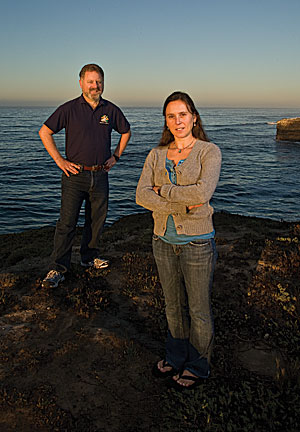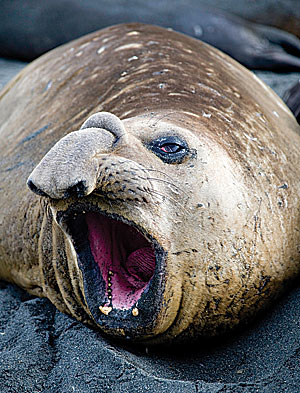The ocean is a trackless wilderness, at least to a landlubber's eye. But to the sea otters, albatrosses, and other animals that call it home, ocean waters delineate habitats and boundaries as clearly as any printed map.
"Marine animals are living in a fluid environment; their habitat is constantly changing. The trick is to understand how they utilize that environment," said Dan Costa, a professor of ecology and evolutionary biology.
Costa studies how marine animals ranging from fur seals to dolphins to penguins make a living in the open ocean. By attaching computerized satellite tags to fur, feathers, or blubber, he can track in real time where an animal goes, when and how deep it dives, and the temperature and salinity of surrounding waters. In 2000, Costa cofounded the Tagging of Pacific Pelagics (TOPP) program for top ocean predators such as great white sharks, bluefin tuna, and elephant seals. Once their migratory routes and critical habitats are known, that data can be used for conservation.
Now in its eighth year, TOPP has been funded primarily by the Alfred P. Sloan, Gordon and Betty Moore, and David and Lucile Packard Foundations, as well as the National Oceanic and Atmospheric Administration, the California Sea Grant program, the Office of Naval Research, and the National Oceanographic Partnership Program.
| Related stories: Endowed-chair funds advance research |
Costa soon realized he could put tag data to a second, more global use--to learn more about the ocean itself.
"I saw that the tags could tell us about the environment that the animals live in, to help understand the ocean environment for its own sake," he said.
Most oceanographic buoys float passively with the currents, limiting their range. But a swimming animal can sample biologically important waters a buoy could never reach. In 2006, Costa and colleagues reported that their 58 tagged southern elephant seals returned more than 4,500 fall and winter seawater measurements from the Southern Ocean, including many dives beneath Antarctic shelf ice, compared with just 148 from ships and floats.
This recent work is just one of many scientific studies and expeditions Costa has led to the southernmost continent over his 30 years in the marine sciences. Just this year, a coastal landform in Antarctica was named the Costa Spur in honor of his contributions to Antarctic research.
When not headed off to do field work in places such as Hawaii and South Africa, Costa has been known to do some serious cycling. He's already completed three AIDS charity rides and would like to do more.
"I recently got an e-mail from the administration about a course on time management," he said, adding with a laugh, "I'd love to go, but I don't have time to take the course."




